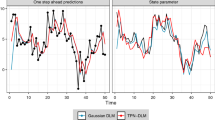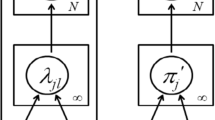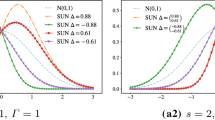Abstract
The most difficult—and often most essential—aspect of many interception and tracking tasks is constructing motion models of the targets. Experts rarely can provide complete information about a target’s expected motion pattern, and fitting parameters for complex motion patterns can require large amounts of training data. Specifying how to parameterize complex motion patterns is in itself a difficult task.
In contrast, Bayesian nonparametric models of target motion are very flexible and generalize well with relatively little training data. We propose modeling target motion patterns as a mixture of Gaussian processes (GP) with a Dirichlet process (DP) prior over mixture weights. The GP provides an adaptive representation for each individual motion pattern, while the DP prior allows us to represent an unknown number of motion patterns. Both automatically adjust the complexity of the motion model based on the available data. Our approach outperforms several parametric models on a helicopter-based car-tracking task on data collected from the greater Boston area.
Similar content being viewed by others
References
Ashbrook, D., & Starner, T. (2003). Using GPS to learn significant locations and predict movement across multiple users. Personal and Ubiquitous Computing, 7(5), 275–286.
Bishop, C. M. (2006). Information science and statistics. Pattern recognition and machine learning. Berlin: Springer.
Boyle, P., & Frean, M. (2005). Dependent Gaussian processes. In Advances in neural information processing systems (Vol. 17, pp. 217–224). Cambridge: MIT Press.
Csató, L., & Opper, M. (2001). Sparse representation for Gaussian process models. In Advances in neural information processing systems (pp. 444–450). Cambridge: MIT Press.
Deisenroth, M. P., Huber, M. F., & Hanebeck, U. D. (2009). Analytic moment-based Gaussian process filtering. In L. Bouttou & M. Littman (Eds.), Proceedings of the 26th international conference on machine learning, Montreal, Canada (pp. 225–232). Easbourne: Omnipress.
Dia, H. (2002). An agent-based approach to modeling driver route choice behaviour under the influence of real-time information. The American Statistician, 10, 331–349.
Duane, S., Kennedy, A. D., Pendleton, B. J., & Roweth, D. (1987). Hybrid Monte Carlo. Physics Letters B, 195(2), 216–222.
Fox, E., Sudderth, E., & Willsky, A. S. (2007). Hierarchical Dirichlet processes for tracking maneuvering targets. In Proc. inter. conf. information fusion.
Girard, A., Rasmussen, C. E., Quintero-Candela, J., & Murray-smith, R. (2003). Gaussian process priors with uncertain inputs—application to multiple-step ahead time series forecasting. In Advances in neural information processing systems (pp. 529–536). Cambridge: MIT Press.
He, R., Bachrach, A., & Roy, N. (2010). Efficient planning under uncertainty for a target-tracking micro-air vehicle. In Proc. IEEE international conference on robotics and automation.
Hsu, D., Lee, W. S., & Rong, N. (2008). A point-based POMDP planner for target tracking. In Proc. IEEE international conference on robotics and automation, Pasadena, CA.
Joseph, J. M., Doshi-Velez, F., & Roy, N. (2010). A Bayesian nonparametric approach to modeling mobility patterns. In AAAI.
Ko, J., & Fox, D. (2009). GP-BayesFilters: Bayesian filtering using Gaussian process prediction and observation models. Autonomous Robots, 27(1), 75–90.
Kurniawati, H., Du, Y., Hsu, D., & Lee, W. (2009). Motion planning under uncertainty for robotic tasks with long time horizons. In Proc. international symposium of robotics research.
Letchner, J., Krumm, J., & Horvitz, E. (2006). Trip router with individualized preferences (TRIP): incorporating personalization into route planning. In AAAI.
Liao, L., Patterson, D. J., Fox, D., & Kautz, H. (2007). Learning and inferring transportation routines. Artificial Intelligence, 171(5–6), 311–331.
Meeds, E., & Osindero, S. (2006). An alternative infinite mixture of Gaussian process experts. In NIPS 18.
Meiring, W., Monestiez, P., Sampson, P., & Guttorp, P. (1997). Developments in the modelling of nonstationary spatial covariance structure from space-time monitoring data. In E. Baafi & N. Schofield (Eds.), Geostatistics wallongong 1996 (pp. 162–173). Dordrecht: Kluwer.
Miller, S. A., Harris, Z. A., & Chong, E. K. P. (2009). A POMDP framework for coordinated guidance of autonomous UAVs for multitarget tracking. EURASIP Journal on Advances in Signal Processing. doi:10.1155/2009/724597.
Paciorek, C. J., & Schervish, M. J. (2000). Nonstationary covariance functions for Gaussian process regression. In Neural information processing systems.
Patterson, D., Liao, L., Fox, D., & Kautz, H. (2003). Inferring high-level behavior from low-level sensors. In Proc. UBICOMP.
Pineau, J., Gordon, G., & Thrun, S. (2003). Point-based value iteration: An anytime algorithm for POMDPs. In International joint conference artificial intelligence (pp. 1025–1032).
Puterman, M. L. (1994). Markov decision processes: discrete stochastic dynamic programming. New York: Wiley.
Raftery, A. (1986). Choosing models for cross-classifications. American Sociological Review, 51, 145–146.
Rasmussen, C. E. (2000). The infinite Gaussian mixture model. In NIPS (p. 12).
Rasmussen, C. E., & Ghahramani, Z. (2002). Infinite mixtures of Gaussian process experts. In NIPS (p. 14).
Rasmussen, C. E., & Williams, C. K. I. (2005). Gaussian Processes for Machine Learning. Adaptive Computation and Machine Learning Series. ISBN 0-262-18253-X.
Ross, S., Pineau, J., Paquet, S., & Chaib-Draa, B. (2008). Online planning algorithms for POMDPs. The Journal of Artificial Intelligence Research, 32, 663–704.
Roy, N., & Earnest, C. (2006). Dynamic action spaces for information gain maximization in search and exploration. doi:10.1109/ACC.2006.1656452.
Snelson, E., & Ghahramani, Z. (2006). Sparse Gaussian processes using pseudo-inputs. In Advances in neural information processing systems (Vol. 18, pp. 1257–1264). Cambridge: MIT Press.
Tay, C., & Laugier, C. (2007). Modelling smooth paths using Gaussian processes. In International conference on field and service robotics.
Teh, Y. W. (2010). Dirichlet processes. In Encyclopedia of machine learning. ISBN 978-0-387-30768-8.
Ziebart, B. D., Maas, A., Bagnell, J., & Dey, A. K. (2008). Maximum entropy inverse reinforcement learning. In AAAI.
Author information
Authors and Affiliations
Corresponding author
Rights and permissions
About this article
Cite this article
Joseph, J., Doshi-Velez, F., Huang, A.S. et al. A Bayesian nonparametric approach to modeling motion patterns. Auton Robot 31, 383–400 (2011). https://doi.org/10.1007/s10514-011-9248-x
Received:
Accepted:
Published:
Issue Date:
DOI: https://doi.org/10.1007/s10514-011-9248-x




